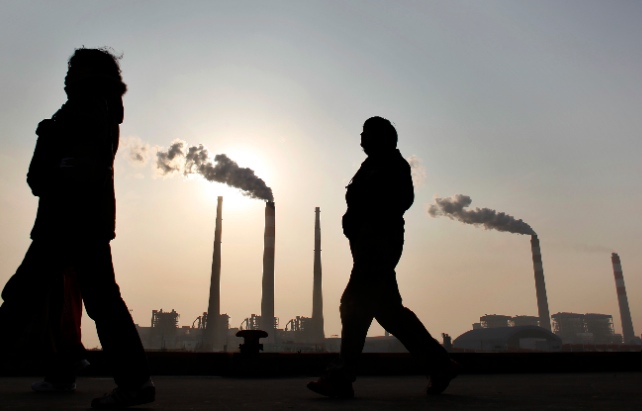Page added on February 29, 2012
Facing the Facts on Fossil Fuel
We are so accustomed to our dependence on petroleum that discussions of alternative energy futures take its convenience and efficiency for granted.
This is Part 1 in a three-part series focusing on fossil-fuel dependence and the intersection of energy and the environment. Part 1 discusses what underpins our current dependence on fossil fuels to meet our energy needs: its unmatched efficiency as an energy source.
 Developed societies have enormous energy needs, which at present can only be met by large-scale energy sources (oil, gas, coal, nuclear power, and hydro). An increased dependence on “unconventional” fossil fuels (oil from oil sands, shale gas) has been met with an increased level of concern about environmental issues surrounding these developments, including proposals for pipelines to carry oil-sands crude, and the “fracking” process required to release gas from deeply buried shales. Protesters, raising concerns about “Canada’s dirty oil,” would like to stop the oil-sands industry and cause pipeline projects to be cancelled. But our dependence on fossil fuels means we need to take a more holistic approach to these issues. At present, without fossil fuels, industrial production would be crippled, there would be no efficient transportation, and there would be little or no economic growth. Despite concerns about fossil-fuel emissions and impacts on climate, we must not lose sight of the critical importance of fossil fuels to developed society. Because of this, climate-change solutions cannot be focused only on Canada’s petroleum industry, which is making strides to reduce its carbon intensity.
Developed societies have enormous energy needs, which at present can only be met by large-scale energy sources (oil, gas, coal, nuclear power, and hydro). An increased dependence on “unconventional” fossil fuels (oil from oil sands, shale gas) has been met with an increased level of concern about environmental issues surrounding these developments, including proposals for pipelines to carry oil-sands crude, and the “fracking” process required to release gas from deeply buried shales. Protesters, raising concerns about “Canada’s dirty oil,” would like to stop the oil-sands industry and cause pipeline projects to be cancelled. But our dependence on fossil fuels means we need to take a more holistic approach to these issues. At present, without fossil fuels, industrial production would be crippled, there would be no efficient transportation, and there would be little or no economic growth. Despite concerns about fossil-fuel emissions and impacts on climate, we must not lose sight of the critical importance of fossil fuels to developed society. Because of this, climate-change solutions cannot be focused only on Canada’s petroleum industry, which is making strides to reduce its carbon intensity.
There is much hopeful talk about a future “low-carbon economy” following a switch to renewable energy, but, at present, the major renewable sources – solar, wind, and biofuel power – cannot provide the necessary substitute, despite much optimistic promotion of a clean, green future. This is true even in jurisdictions where there has been heavy investment in renewables: Consider the wind farms of Denmark and Germany, which only meet five to 20 per cent of the countries’ electricity needs. Wind is too variable to provide a steady base-load capacity – coal, gas, or other traditional power sources need to be retained for this purpose. Furthermore, the scale of the needs is commonly misunderstood. A typical thermal-power plant (gas, coal, nuclear) can generate 200-2,000 MW of electricity continuously, whereas the most powerful modern wind turbines only generate three MW in the same timeframe under ideal conditions (i.e. when the wind is blowing at the right speed, which seems to only be about 30 per cent of the time). Thus, thousands of wind turbines are needed to make a real difference, and backup thermal-power plants must still be retained.
There is an increasingly urgent need to develop new and cheaper renewable-energy technologies. For one thing, the supply of petroleum is finite (something I will discuss in more detail in Part 2 of this series). For some applications – air transportation and the manufacture of plastics and other synthetic materials being among the most important – there is currently no substitute for petroleum. As a developed society, we often fail to recognize our enormous dependence on fossil fuels for these purposes.
Current renewable technologies, in addition to being of limited use, are very inefficient. In order to measure the efficiency of various energy sources, economists have created an index called the Energy Return on Energy Invested (EROEI), which considers how much energy it takes to get the useful energy out (for example, the energy required to drill a well). EROEI can help us understand which energy sources promise a good return on investment. It tells us, for instance, that petroleum has decreased in its returns over the last several decades. At the beginning of the petroleum age, and until the 1970s, the return on petroleum energy invested was about 100:1 (100 units of energy were produced per one unit of energy invested). However, the increasing need to search for reserves in remote or hostile territory, such as the deep offshore, is steadily reducing the returns to less than 20:1.
Providing insight into the returns on investment for various energy sources, EROEI gives us a sense of their value and their likelihood of use for the foreseeable future:
- Unconventional petroleum sources, including oil sands and shale gas, have indices in the 5-10:1 range.
- Nuclear power, notwithstanding the huge start-up and maintenance costs, has an index in the 15:1 range.
- Hydro power and coal have impressive indices in the 100:1 range.
- Wind looks competitive with unconventional petroleum, at an estimated 18:1, but only when the wind is blowing.
- Solar power is in the range of 2-8:1.
- For some biofuels, calculations suggest that the index is less than one – that it takes more energy to create the fuel than is delivered upon combustion.
- Geothermal energy could have great potential as a heat source and for electricity generation, but remains largely untapped.
Based on this index, then, it looks like fossil fuels like coal, oil, and natural gas (as well as nuclear power and hydro) will remain essential to meeting electricity generation needs for many years yet. In the developed areas of the world, we are so accustomed to dependence on petroleum that we take its convenience and efficiency for granted. The compactness, flexibility, transportability, and energy density (the amount of energy per unit mass) of liquid oil and natural gas are currently unchallenged by the other sources. To continue the supply of these resources as long as possible requires drilling in more difficult areas, using more invasive technology, and expanding the infrastructure of plants and pipelines for delivery to the places it is needed. These developments raise legitimate environmental concerns, an important factor that I will discuss in the third article in this series. While it is naïve to think that our energy supply can be transformed overnight, the pressure to make this transformation is also linked to the finite nature of oil and gas, which I will explore in more detail in Part 2.
5 Comments on "Facing the Facts on Fossil Fuel"


DC on Wed, 29th Feb 2012 7:55 pm
I would like to know how Coal gets 100:1 ERoEI? and Solar 2.8 to 1. I have never seen any reputable research supporting either of these figures. Solar may not have oils EROEI, but its NOT worse than tar-sands@5:1 , and tars sands does not come close to the 10:1 quoted. In fact, the numbers seem selected to steer a reader to a desired conclusion.
‘Namely’
Fossil-fuels bad-sure, but we gota keep useing em!
Coal-AWESOME EROI, As good as OIL over 100 years ago! Amazing, A century of digging up all the HQ coal seams and setting fire to it has barely effected it!
Solar and Wind-, bad, Low EROI, cant really rely on em…too bad…
The source quoted is a Murphy Hall 2010.
MrEnergyCzar on Wed, 29th Feb 2012 8:49 pm
I think the sands run 5 to 1, wind 10 to 1 , solar probably 3 to 1.
MrEnergyCzar
Serial_Worrier on Wed, 29th Feb 2012 9:30 pm
Solar & wind are objectively worse EROEI then fossil fuels, why is it so hard to accept that?
BillT on Thu, 1st Mar 2012 1:23 am
TOTAL EROEI would put ALL energy sources under 10:1 with most under 2:1 and some at negative numbers. I have not seen any studies that take into account the legacy energy system we use today that was made from cheap, plentiful oil and will NOT be able to be replaced when it wears out. All of the hundreds of thousands of heavy machines that mine, haul and refine the starting materials for ALL energy sources, will NOT be made with PV solar or wind or any other renewable, ever. When they are gone, it is over, even if there are still minerals to recover.
BillT on Thu, 1st Mar 2012 1:33 am
BTW: A concrete cooling tower for a nuke plant takes about 250,000 cy of concrete. That equals about 250,000 barrels of oil to manufacture the concrete material that goes into the tower. Does NOT include the steel, transport costs, construction costs, labor costs or the base it sits on. ALL of those require oil in huge quantities. And this is just one part of a nuke plant. Anyone who claims that nuclear is 15:1 is a fool or a shill of the nuclear industry. Actual ratio is likely negative when ALL facts are considered.